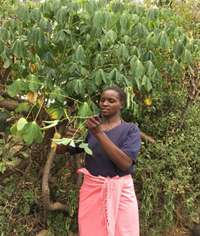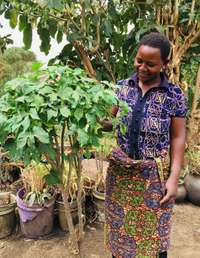During 2022, 24 pieces of training occurred in hospitals and clinics in two Maasai districts through the support of ECHO EA trainers who taught 1,740 trainees in both the Maasai and Swahili languages. Participants were provided with training about three or four high-protein perennial vegetables, their importance in improving nutrition and overall health status, and their resilience in harsh environments. They were demonstrated how to properly establish, harvest, prepare, and cook the green vegetable leaves, given cautions about potential toxicity if not cooked properly, given Swahili handouts describing these training aspects, and an opportunity to taste the cooked results. Attendees were also given seeds or cuttings as described below, shown how to plant them, and encouraged to grow them at their homesteads. The focus on perennial vegetables was because they are a highly diverse and underutilized class of plants. They offer the impressive potential to address nutrient deficiencies impacting billions of people around the world. Their suitability to a wide range of climates, as well as for growing in adverse conditions compared to annual vegetables, indicates a potential for scaling up production across a broad geographic range.
Between January – February 2023 an impact assessment was made to try to determine whether ECHO East Africa’s initiative to train hundreds of clinic attendees at mother and child health clinics was an effective way to promote perennial vegetables and introduce them into the diets of participants. The survey involved those who took their children to clinics. A sample of 194 respondents from the two Maasai districts was interviewed by mobile phone using the same questionnaire.
From the results, the majority of respondents indicated they were provided with Chaya cuttings and some other perennial planting materials. 80.4% of the respondents reported receiving cuttings (for Chaya and Cassava leaf) and Moringa seeds for Monduli (84.1%) and Longido (77.4%). 71.1% of the people provided with Chaya cuttings managed to grow them, but 22.2% of the cuttings did not reach the maturity or harvesting stage. This implies that there is still a low availability of these perennial vegetables at many homesteads. However, for those that have been successfully planted, due to the high multiplying effect of these perennial vegetables, there’s a high chance of increased availability if shared by neighbors in the future. For instance, at the ECHO East Africa office where it started with 3 Chaya cuttings in 2012, it has shared them with over 20,000 homesteads in Arusha and beyond. Another anecdote sharing the potential spread effect is the story of how Chaya has spread in Zanzibar http://edn.link/chayastory.

Figure 17. Teddy Mathayo received training at Mbuyuni Health Center, received Cassava leaf cuttings, and successfully grew them. She described how she benefited from them. Source: ECHO East Africa Staff
Among the 71.1% who managed to grow them at their homesteads, only 54.1% responded that the perennial vegetables sprouted. This was not surprising as 2022 was a particularly dry year, and it was anticipated that it might be difficult for many to water the plants, given the scarcity of water for household use in these Maasai districts. By the date of the assessment, the majority of the respondents had not reached the point of harvesting the perennial vegetables (86.1%). Only 8.2% of respondents reported having started to harvest, but even among them, only once. For those who harvested and consumed the perennial vegetables, some changes were reported among the family members, especially among the children. 50% of parents reported health improvements, 37.8% perceived improved children’s growth, 25.6% perceived improved appetites, 12.1% perceived smoother skin and 6% grew them to get Moringa seeds. Different research findings have reported that perennial vegetables are very rich in nutrients compared to other annual vegetables, with increases in such as Vitamin C, zinc, iron, iodine, and folate (Kennedy David, 2011).
Food insecurity parameters were also assessed in the survey using the 9-Question tool. As in other developing countries in Africa, typical diets in this study showed consumption of more carbohydrates as food staples; about 52.1% consumed high carbohydrate foods more than 8 times a week (about 1 meal per day) while 45.9% consumed 1-3 times a day. The most affected districts by malnutrition in Arusha are Longido and Monduli where 30% and 25% of the population respectively are food-insecure with limited food availability and accessibility (Tanzania National Nutrition Survey, 2021). High food prices are the second most important shock and are reported by 12% of the population (WFP, 2007).

Figure 18. Mrs. Leons Kiondo poses in front of her Chaya received during the training at Monduli District Hospital. Source: ECHO East Africa Staff
However, the consumption of vegetables was the main focus of the survey, this showed a greater response in terms of daily and past week consumption (58.8%). The respondents managed to answer questions regarding all of the foods listed with their consumption levels which indicated an inadequate intake of some of the essential nutrients such as iron, zinc, and vitamin C due to low intake of foods containing nutrients.
Drought is a very significant shock experienced in much of Tanzania over the past fifteen years. Places, where the survey was conducted, are more prone to drought. Regarding gardening activities, the respondents reported drought (46.1%) and pests and diseases (37.1%) as major challenges. The respondents wished to practice irrigation to overcome the problem of drought but most respondents stated this was not possible due to the scarcity of water where they live; it becomes too difficult for them, and thus, the cuttings failed to grow and survive.
On the assessment of food security in general, most faced challenges due to a lack of resources in the Maasai communities. Most women are involved in home activities. Few have home gardens. They spend hours fetching water and firewood, and taking care of children while men go for herding or other activities. At the same time, families in Maasai communities depend on a husband to take all of the decisions. As a result, some families failed to consume food for a whole day (10.8%). From the survey, some families consumed foods that were not of their preference due to their economic situation which may have led to nutrient inadequacy.
Outcomes/recommendations from the assessment:
This survey found that perennial vegetables which may be the best alternative to address nutrient deficiencies. From our experience, with a few families having these plant resources in their homesteads, there is a good opportunity for sharing among themselves, and awareness has been raised due to the training.
The research team determined that it was a disappointing year for establishing the perennial vegetables, in that drought was so widespread, and there was not a high survival of the cuttings in more homesteads; the plant materials need to be introduced during the rainy season when moisture is present to increase survivability. Notwithstanding, because resources are available, the ECHO EA team is preparing for a re-training effort,
- to provide more training to people, especially in rural areas as they are the ones more prone to health and food insecurity compared to urban areas, and as they are more vulnerable to drought, especially this year
- to encourage those whose perennial vegetables survived to share with their neighbors
- to try to make the best use of the rains and household water, that is, to emphasize the re-use of household bath and kitchen water to establish the perennial vegetables as the plants are drought-hardy once established
- to do more frequent monitoring to ensure the training effectiveness and success, but also to encourage the community members by learning of constraints and helping them to overcome problems during their implementation.
Thus, perennial vegetables still have the potential to play an important role in increasing better diets, availability of highly nutritious plants which produce year-round, providing fresh greens of high nutritive status, increasing soil fertility, and soil biodiversity, and improving the overall health status of people living in drylands. Read more regarding perennial vegetable-rich nutrients http://edn.link/hzt7ka.